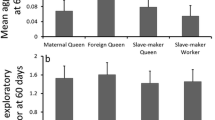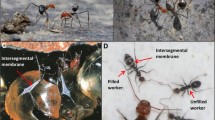Abstract
The mating and postmating behavior of reproductives belonging to two sympatric dulotic colonies of the facultative slave-making ant Formica sanguinea was analyzed in the field. Our observations showed that the European blood-red ant adopts a reproductive behavior similar to the “male aggregation syndrome.” Newly mated females return to a dulotic colony and often wait for a raid. Following a slave raid is an advantageous strategy to locate and invade host nests and to establish a new dulotic colony. In the laboratory, the following modes of colony founding were studied: independent, adoption, alliance, usurpation, and brood raiding. Independent foundation was possible only when several females were kept together. Alliance was obtained with females of two potential slave species (F. cunicularia, F. rufibarbis). Usurpation and adoption were more frequent in the incipient than in the mature host colonies. Mixed colonies were always obtained after the sack of the host pupae. It seems likely that, rather than conspecific adoption followed by budding, F. sanguinea relies on temporary parasitism to start new colonies.
Similar content being viewed by others
REFERENCES
Bourke, A. F. G., and Franks, N. R. (1995). Social Evolution in Ants, Princeton University Press, Princeton, NJ.
Buschinger, A. (1986). Evolution of social parasitism in ants. TREE 1: 155–160.
Buschinger, A., and Klump, B. (1988). Novel strategy of host-colony exploitation in a permanently parasitic ant, Doronomyrmex goesswaldi. Naturwissenschaften 75: 577–578.
Cool-Kwait, E., and Topoff, H. (1984). Raid organization and behavioral development in the slave-making ant Polyergus lucidus Mayr. Insectes Soc. 31: 361–374.
Hasegawa, E., and Yamaguchi, T. (1994). Raiding behavior of the Japanese slave-making ant Polyergus samurai. Insectes Soc. 41: 279–289.
Hölldobler, B., and Bartz, S. H. (1985). Sociobiology of reproduction in ants. In Hölldobler, B., and Lindauer, M. (eds.), Experimental Behavioral Ecology and Sociobiology, G. Fisher Verlag, Stuttgart, New York, pp. 237–257.
Hölldobler, B., and Wilson, E. O. (1990). The Ants, Belknap Press of Harvard University Press, Cambridge, MA.
Ito, F., and Higashi, S. (1990). Temporary social parasitism in the enslaving ant species Formica sanguinea Latreille: An important discovery related to the evolution of dulosis in Formica ants. J. Ethol. 8: 33–35.
Keller, L. (1991). Queen number, mode of colony founding, and queen reproductive success in ants (Hymenoptera Formicidae). Ethol. Ecol. Evol. 3: 307–316.
Marlin, J. C. (1971). The mating, nesting and ant enemies of Polyergus lucidus Mayr (Hymenoptera: Formicidae). Am. Midl. Nat. 86: 181–189.
Mori, A., Grasso, D. A., and Le Moli, F. (1991). Eco-ethological study on raiding behaviour of the European amazon ant, Polyergus rufescens Latr. (Hymenoptera: Formicidae). Ethology 88: 46–62.
Pamilo, P., and Seppä, P. (1994). Reproductive competition and conflicts in colonies of the ant Formica sanguinea. Anim. Behav. 48: 1201–1206.
Pamilo, P., and Varvio-Aho, S. (1979). Genetic structure of nests in the ant Formica sanguinea. Behav. Ecol. Sociobiol. 6: 91–98.
Savolainen, R., and Deslippe, R. J. (1996). Facultative and obligate slavery in formicine ants: Frequency of slavery, and proportion and size of slaves. Biol. J. Linn. Soc. 57: 47–58.
Stitz, H. (1939) Ameisen oder Formicidae. In Dahl, F. (ed.), Die Tierwelt Deutschlands. 37. Teil, G. Fisher Verlag, Jena, pp. 316–324.
Talbot, M. (1968). Flights of the ant Polyergus lucidus Mayr. Psyche 75: 46–52.
Topoff, H. (1990). Slave-making ants. Am. Sci. 78: 520–528.
Topoff, H., and Greenberg, L. (1988). Mating behavior of the socially parasitic ant, Polyergus breviceps: The role of the mandibular glands. Psyche 95: 81–87.
Topoff, H., Weickert, T., and Zimmerli, E. (1990). A comparative study of colony takeover between queens of facultative and obligatory slave-making ants (Hymenoptera: Formicidae). J. Insect Behav. 3: 813–817.
Viehmeyer, H. (1908). Zur Koloniegründung der parasitischen Ameisen. Biol. Cbl. 28: 18–32.
Wasmann, E. (1908). Weitere Beiträge zum sozialen Parasitismus und der Sklaverei bei den Ameisen. Biol. Cbl. 28: 257–271.
Wheeler, W. M. (1906). On the founding of colonies by queen ants, with special reference to the parasitic and slave-making species. Bull. Am. Mus. Nat. Hist. 22: 33–105.
Author information
Authors and Affiliations
Rights and permissions
About this article
Cite this article
Mori, A., Le Moli, F. Mating Behavior and Colony Founding of the Slave-Making Ant Formica sanguinea (Hymenoptera: Formicidae). Journal of Insect Behavior 11, 235–245 (1998). https://doi.org/10.1023/A:1021048024219
Issue Date:
DOI: https://doi.org/10.1023/A:1021048024219




